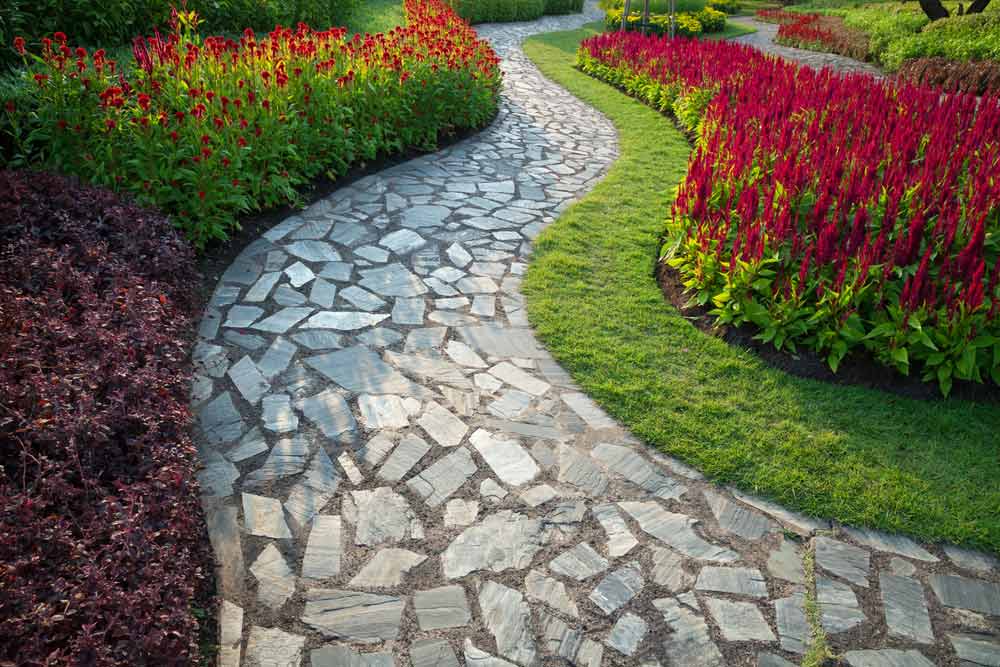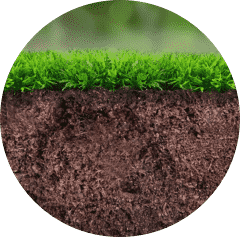Creating a captivating outdoor space involves more than just planting a few trees. The true beauty of landscape design lies in the thoughtful blend of hardscaping and softscaping. These two elements work together to create an aesthetically pleasing and functional environment. In this blog post, we’ll help you understand their role in creating stunning spaces.

What Is Hardscaping?
Hardscaping refers to the non-living elements of a landscape design. These features provide structure and functionality, creating a foundation upon which the living components of your garden can thrive. Common hardscaping elements include pathways, patios, retaining walls and decorative stone features. These structures define the layout of your outdoor space and enhance its usability. For instance, pathways guide foot traffic and create a sense of order, while retaining walls can manage soil erosion and create terraced levels in your garden.
In addition to their practical benefits, hardscaping elements add aesthetic value to your landscape. They can also influence the microclimate of your garden, with stone and concrete surfaces absorbing and radiating heat, which can extend the usability of your outdoor space into cooler months.
What Is Softscaping?
Softscaping involves the living components of a landscape, such as plants, trees, shrubs, flowers and grass. These elements bring colour, texture and life to your outdoor space, creating a natural and inviting atmosphere. Softscaping is essential for achieving a balanced and harmonious landscape design.
The placement and arrangement of softscaping elements can significantly influence the overall look and feel of your landscape. Layering plants of different heights, textures and colours can create depth and visual interest, while the strategic use of trees and shrubs can frame views.
Material Choices In Hardscaping
When it comes to hardscaping, the choice of materials is vital. Each material offers unique characteristics and advantages, impacting the appearance and durability of your landscape features. Here are some popular materials used in hardscaping:
- Natural Stone: Provides a timeless, rustic look and is highly durable.
- Concrete: Versatile and cost-effective, suitable for various applications.
- Brick: Adds a classic, traditional feel and is excellent for creating patterns.
- Gravel: Ideal for pathways and areas requiring good drainage.
- Wood: Offers a natural, warm aesthetic, perfect for decking and fencing.
Plant Selection In Softscaping
Here are some considerations for plant selection:
- Climate Adaptability: Choose plants that thrive in your local climate. This ensures they require less maintenance and are more likely to flourish.
- Seasonal Interest: Incorporate a variety of plants that bloom at different times of the year to maintain visual interest throughout the seasons.
- Functional Benefits: Consider plants that provide specific functions, such as shade trees for cooling, hedges for privacy and flowering plants for attracting pollinators.
Balancing Hardscaping And Softscaping In Landscape Design
Achieving the perfect balance between hardscaping and softscaping is essential for a well-rounded landscape design. Too much hardscaping can make a space feel cold and uninviting, while excessive softscaping might lack structure and functionality. The key is to create a harmonious blend that enhances the beauty and usability of your outdoor space. For example, a patio can serve as a central gathering spot, while pathways guide visitors through different sections of the garden. Surrounding these features with lush greenery and vibrant flowers softens the overall look and creates a more inviting atmosphere.
In addition, consider the flow and transition between hardscaping and softscaping elements. Smooth transitions, such as gradually blending a stone pathway into a flower bed, can create a seamless and cohesive design.
Contact Our Landscapers On The Sunshine Coast
At Sunshine Coast Turf, we understand the importance of creating a balanced and beautiful landscape. Our landscape designers are here to help you achieve the perfect harmony between hardscaping and softscaping. Whether you’re looking to transform your garden into a tranquil retreat or a vibrant entertainment space, our team has the knowledge and experience to bring your ideas to life. To learn more about landscaping on the Sunshine Coast, get in touch with us today!




